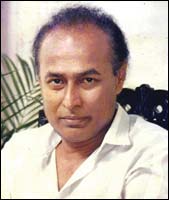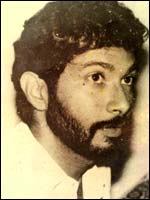Peeping into (un)known passages
Aravinda Hettiarachchi
Just after Gamini Fonseka’s death, Marxist film critic and director
Shelton Payagala noted: “it is a crime that a genius of this calibre was
born into an underdeveloped country such as this.”
In the 1980’s, Steven Spielberg, who directed the film Indiana Jones,
said to D R Nanayakakare (a Sri Lankan actor of vast talent), “If you
were born in the United States of America you would be a genius in the
whole acting world.”
The meaning of these two sentiments is not mere information but of a
phenomenon manifesting a clear politico-cultural perspective of what is
happening with creative people in the field of Sri Lankan art.
|

Gamini Fonseka |

Richard de Soyza |

D R Nanayakkara |
In this sense, if the first sentiment questions this, then the second
one provides a common answer. Even as most people who have endured a
long career in the field of Sri Lankan art already know, this question
and the answer, in a certain way, represent their unspoken destiny.
To me, this question is deadly and the answer has no value because
the solution or the answer to this question is not that we must
establish our own art form in a country or an area totally foreign to
us. We must develop a better field of art of our own in Sri Lanka. In
another way there should be an appropriate industry to do it.
The whole narrative of this sketch indicates the difference in the
cultural milieu Gamini and D R were brought up. For the micro
socio-cultural differences separating these two actors appear in the
macro socio-cultural differences of the society. The other part of this
tale shows the difference between Euro-US and Sri Lankan capital
intervention in the industry of cinema arte.
In 1988, Richard de Soyza conducted the drama workshop Wadumaduwa;
most of the Sinhala speaking people interested in drama were given
opportunity to mingle with the English speaking elite.
Some of them were able to participate in most of the drama workshops
sponsored by the British Council with various western dramatists such as
Scott Richards, Rudi Corens, Chris Connelly and others.
This opportunity was offered to Sinhala middle and lower middle
class, as well as ordinary people through the upper-middle class image
Richard and a few other people in Sri Lanka had at that time. This was,
in a certain way, similar to the cultural class image of Gamini Fonseka.
In a way it was similar to Fonseka’s style. On the other hand,
Richard was experimenting with his ability to deal with a variety of
cultural classes in theatre - for he was a man who always tried to run
against the wind.
As an individual, he could not personally create total cooperation or
a change between these classes. Yet the people who participated at these
collected drama workshops represented socio-cultural classes close to D
R’s (middle, lower-middle and ordinary) who rarely had the opportunity
to deal with a variety of cultural classes, especially with the cultural
classes over them.
Richard himself personally intervened to facilitate this particular
cultural connect to a certain extent. He once even provided Lionel Wendt
rehearsal space to the street drama circle of Gamini Hattetuwegama. (But
the moment Richard left the scene these people were chased away from the
rehearsal place. After all, it was at the height of ‘88-89’ insurgency
and after that, it was as if nothing like what he had done had ever
taken place.)
So while Richard’s exceptional intervention in the drama workshop let
mingle classes unknown to each other, most of the Sinhala speaking
middle, lower-middle class and ordinary drama people, while accepting
these upper and upper-middle class people as colleagues, were aware that
they were not ‘down-to-earth’ people. Perhaps, and to a certain extent,
most of them were affected by the backdrops of the rebellious political
atmosphere at the time.
Each of these classes possessed clever drama artistes with great
talent, most of them being serious about their art. At that time,
majority of common viewing audiences, representing the class backgrounds
of D R Nanayakkara , knew only of a few artistes of the upper middle
class such as Gamini Fonseka, Iranganie Serasinghe and Winston
Serasinghe, only because these artistes worked in Sinhala speaking
cultural arena of arte.
And to a certain extent, the audience had an intimate relationship
with these cultural workers (while Richard de Soyza and Manorani
Saravanamuttu, also of that class, came closer to common people’s hearts
through political interaction, and not mainly through the spectacle of
art). To this day, most of the major factors of these contradictions
have been swept under the carpet.
Up to the 1990s, most of general Sinhala-listening audiences
preferred to view or taste the aesthetic and artistic abilities of
Malini Fonseka and not Thusitha Jayasundara (one of the most talented
English theatre actress in Sri Lanka and England), Channa Wijewardena
but not Chandri Pieris (excellent dancer in Sri Lanka and England),
Rohana Weerasingahe but not Harsha Makalanda, Sarath Madu and George
Keyt, Priyankara Rathnayake but not Dylan Perera, Vajira Chithrasena but
not Oosha Saravanamuttu.
On the other hand, most English-speaking audiences prefer to view or
taste not only the latter artists not the former. The present situation
and shape of this phenomenon now differ from those good or bad old days
I have tried to describe in this unfinished sketch.
Even today, upper and upper-middle class English speaking cultural
society invite Sinaha speaking middle class artistes such as Ravibandu
Vidyapathi for their cultural rituals in the Lionel Wendt or St.
Bridget’s auditorium. Yet these cultural arenas are as alienated to each
other as two foreign countries.
Who is going to build a bridge between them?
|



